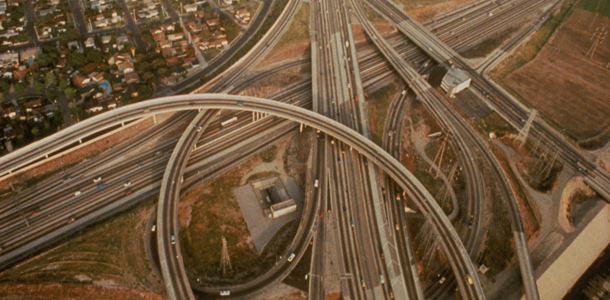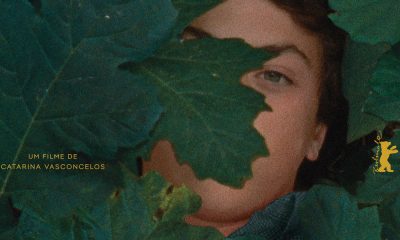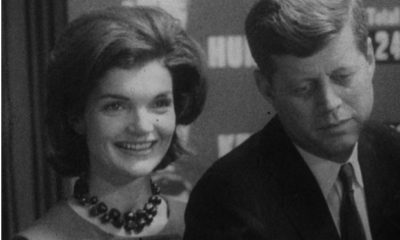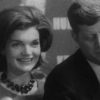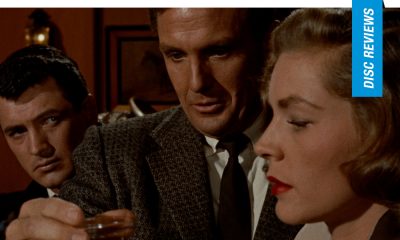Disc Reviews
Criterion Collection: The Qatsi Trilogy | Blu-ray Review
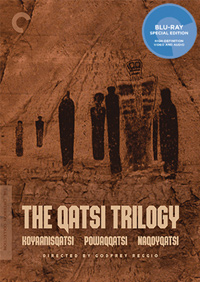 The Qatsi Trilogy is a collection of films made by Godfrey Reggio between 1983 and 2002. Each film offers an extraordinary and unforgettable cinematic experience, and their messages are, astonishingly, even more pertinent and vital today. The visual and aural wonders of The Qatsi Trilogy fall into no preset genre or easily explainable category of filmmaking. The simplest description would be a grafting of somber political treatise with I-Max style sensory joyride.
The Qatsi Trilogy is a collection of films made by Godfrey Reggio between 1983 and 2002. Each film offers an extraordinary and unforgettable cinematic experience, and their messages are, astonishingly, even more pertinent and vital today. The visual and aural wonders of The Qatsi Trilogy fall into no preset genre or easily explainable category of filmmaking. The simplest description would be a grafting of somber political treatise with I-Max style sensory joyride.
To fully understand these unique works, one must understand the filmmaker, and his singular background and sensibilities. Godfrey Reggio is not an assembly line graduate of the USC film school. In fact, he spent the 1960s as a social worker and political activist, founding several community programs for disadvantaged youth in New Mexico. He also spent 14 years in training for the priesthood, but abandoned that quest to pursue a deeper understanding of the philosophy and mysticism of the Hopi Indians.
Reggio is, in short, a spiritual pilgrim with an Arriflex, and his films question the basic tenets of modern life, using the most basic components of cinema. Reggio’s wordless mediations consist exclusively of images and music, and through time-shifting scenes of the natural and man-made worlds, supported by Philip Glass’s expressive and omnipresent score, Reggio creates a beautiful sensory language that articulates his complex ideas directly to the human soul.
Koyaanisqatsi (1983) leads off the set, and viewers will find themselves mesmerized from the opening frames. The title is Hopi for “life out of balance,” and over the next 90 minutes, Reggio builds a compelling portrait of the insanity of modern life brick-by-brick. While Reggio’s films don’t follow a narrative per se, Koyaanisqatsi begins with a tone poem evoking Earth’s creation. Majestic vistas of pristine Monument Valley and Canyon de Chelly ultimately give way to aerial shots of the various grids imposed on Earth by man, and the dusty havoc wrought on the planet by his extractive industries.
Reggio’s camera eventually makes its way to the steel canyons of Manhattan. What follows is a time lapse montage that stuns and stupefies. Human beings are reduced to mere machine cogs, as long lens shots of crowded midtown streets and undercranked scenes of Grand Central Station at rush hour combine with Glass’ frenetic score to issue a blistering condemnation of technological society. Koyaanisqatsi is a luscious tableau that raises the cinematic experience to the level of the carnal, and seduces and horrifies in equal measure.
The title of Powaqqatsi (1988) translates as “Parasite” and here Reggio shifts his attention to the trauma inflicted on the Third World by industrialization. As workers covered in mud scurry into a mine in Pakistan and Bedouins drag heavy loads through a desert sandstorm, a chorus of children’s voices echo the ghostly chants of a lost culture. An Indian commuter train, bulging with riders, slowly makes its way through an impoverished city choked with thick smog, while Sikh and Buddhist holy men pray for divine providence.
The scope of Glass’ chart widens here as well, incorporating percussive and indigenous instruments. While not as visually bombastic as its predecessor, Powaqqatsi has its share of money shots. Scenes of village life rendered in rippling waters give the proceedings an arresting impressionistic quality, and a slow motion shot of a young Latin American girl in a frilly dress walking past a bullet riddled wall with “Long Live Guerrilla War” scribbled in graffiti will leave viewers haunted and breathless. On its initial release, Powaqqatsi did not receive the universal acclaim of Koyannisqatsi, but viewed with today’s eyes it is a work of mystical prescience. In the 25 years hence, its fevered denunciation of the global economy rings with a despairing truth.
Naqoyqatsi (2002), in essence “War as a Way of Life”, rounds out the trilogy and serves as a powerful and disturbing coda. Working mainly with stock footage and computer manipulated imagery, Reggio casts daggers into the heart of the digital age and its rampant depersonalization. Virtually no ill of the new century is left unscathed, as Reggio cleverly tackles the medical industry, athletes on steroids, relentless advertising and the venal alliances of our politicians, to name a few. In his most potent metaphor, Reggio uses old footage of crash test dummies to draw a staggering equation to victims of terror, leaving a nightmarish aftertaste. In support is Glass’ lushly orchestrated score, featuring cello lines from Yo-Yo Ma that seem dispatched from another world.
Constructed in three acts, Naqoyqatsi’s final stanza draws Reggio’s two decades of observations to their logical, and devastating, conclusion. As the dogs of war unleash weapons of ever greater destruction, history’s great works of art liquify and literally melt into each other, as a culture races unabated to its self-inflicted annihilation. As skydivers flirt with death in a search for cheap thrills, the universe reclaims its besotted and ruined celestial offspring, leaving only a field of star dust where a great society once stood. And we are back to where Koyannisqatsi began, with weathered petroglyphs as mute witness to man’s perfidious folly.
Disc Review
The transfers here are outstanding, in particular Modern VIdeofilm’s original camera negative conversion of Koyannisqatsi which, along with Powaqqatsi, is presented in 1.85:1. Naqoyqatsi, which consists heavily of digital imagery, is shown in its original 1.78:1 frame. Each production element, whether film or digital, has been traced as far back to its original as possible; clearly a painstaking process. The effort is worth it, as each film glows with a splendor worthy of their lofty subject. Each film features a remastered 5.1 track of startling dynamics and soundstage. The overall effect greatly enhances Reggio’s hypnotic images, and during Naqoyqatsi you’ll probably think Yo-Yo Ma is in the room with you.
Essence of Life, an interview program with Reggio and composer Philip Glass on Koyaanisqatsi
Reggio, who claims people think his films are “either brilliant or shit,” discusses his religious background and the inspiration he draws from religious leaders. We learn that he began with a series of PSAs concerning the lose of privacy in an information age. Glass details a number of images in the film that have become iconic and often copied. He reveals that he worked on Koyaanisqatsi’s score for 3 years, adjusting and tweaking until film and music developed an organic flow. The piece is 25 minutes in duration.
New interview with cinematographer Ron Fricke about Koyaanisqatsi
Through 16mm tests and behind the scenes footage, we learn much about Koyaanisqatsi’s humble origins. Fricke discusses his background as an artist, an how he learned to employ portrait photography techniques to landscapes. 16 min.
Television spots and a new interview with Reggio relating to his 1970s multimedia privacy campaign in New Mexico
In the 1970s, Reggio started in the film business by writing and directing a series of PSAs concerning the invasion of privacy by modern technology. Here he discusses the purpose of the campaign and his attempts to get funding from the ACLU. The spots are shown in their entirety, and they’re quite chilling and prophetic.
Early forty-minute demo version of Koyaanisqatsi with a partial scratch soundtrack featuring poet Allen Ginsberg, along with a new introduction by Reggio
The demo has some interesting discrepancies from the final product, including several scenes filmed at The National Air and Space Museum that were ultimately omitted. At one time, a soundtrack consisting solely of Allen Ginsberg’s poetry was considered, and two short examples are included.
New interview with Reggio about Koyaanisqatsi’s original visual concept, with behind-the-scenes footage
Surprisingly, Reggio originally conceived this sprawling film as taking place in studio, with actors, on surreally symbolic sets. Several examples are included here and by Reggio’s own admission the effect is quite amateurish and corny. 5 minutes.
Impact of Progress, an interview program with Reggio and Glass on their collaboration
In this 20 minute supplement, the men discuss their creative approaches, and the changes in techniques from Koyaanisqatsi to Powaqqatsi. Reggio saw he and Glass as equal partners, with both artists relying heavily on intuition. Glass saw Powaqqatsi as an opportunity to further explore world music. He traveled with the film crew in his search for indigenous musicians, and was especially inspired by the music of Africa and South America.
Inspiration and Ideas, a new interview with Reggio about his greatest influences and teachers
Reggio talks about his background and inspirational heros, none of whom, interestingly enough, are filmmakers. He credits Ivan Illitch, priest and philosopher, and Hopi clan leader David Monongye with teaching him the concepts presented in The Qatsi Trilogy. Reggio also found inspiration in the books of author Jaques Ellul, sociologist and frequent critic of the changes wrought by technology. 18 min.
Public television interview with Reggio from 1989 about the trilogy
This locally produced program from Santa Fe is a truly vital supplement, and will give viewers a concise and interesting introduction to Reggio’s oeuvre. The show features numerous clips from the films, and Reggio talks at length about the production. He describes himself as a “Cultural Kamikazi”, using many of the tools he criticizes in his work. Reggio goes in depth on the importance of Hopi philosophy, and his attempts to adopt a Hopi point of view when creating ideas for Koyaanisqatsi. The piece consists of 19 well-spent minutes.
Anima Mundi (1992), Reggio’s twenty-eight-minute montage of footage of over seventy animal species, scored by Glass
Produced for Italian television, this film bears many similarities to Koyanniqatsi, but deals mainly with the processes of the natural world. There are a number of spectacular vistas here, including a montage of evolution, quite similar in design to Terrence Malick’s underwater sequences from The Tree of Life.
New video afterword by Reggio on the trilogy
Reggio offers a summation of his experiences in making the trilogy, and profusely thanks his collaborators. He makes some interesting observations, namely that “filmmaking is like having many lives in one.” He also describes his films as “having only what Hollywood would call second unit photography” as actors and characters have been stripped away. 15 minutes.
The Making of Naqoyqatsi a brief documentary featuring interviews with the production crew
In this four minute segment we meet Naqoyqatsi’s visual designer John Kane and producer Joe Beirne, who offer their thoughts on the production.
Panel discussion on Naqoyqatsi from 2003, with Reggio, Glass, editor Jon Kane, and music critic John Rockwell
Recorded after a screening of Naqoyqatsi at NYU, here the creative principals reunite for a thorough discussion of the trilogy and its uniqueness in American cinema. Most of the information here has been previously covered, making the 55 minute conference rather redundant.
Interview with Glass and cellist Yo-Yo Ma
Glass and Yo-Yo Ma discuss the music of Naqoyqatsi, in particular the use of the cello as a stand-in for the voice of humanity. The chat gets a bit deep in the weeds as to the technicalities of recording and performance, but music fans will enjoy the insights of these two giants of the industry. 7 minutes.
Trailers
The original theatrical trailer for each film is included.
PLUS: A booklet featuring essays by film scholar Scott MacDonald, Rockwell, and author and environmentalist Bill McKibben
The set is accompanied by a 36 page booklet detailing cinematic and musical aspects of The Qatsi Trilogy. Of particular interest is McKibben’s essay, in which the famous environmentalist dissects the trilogy’s messaging on climate change, and how that message has been generally ignored by society. As expected, the writing is vivid and impassioned. Color film stills and notes on the transfer round out the edition.
Final Thoughts
This reviewer first encountered Koyannisqatsi in the mid-1980s. when a local art house ran it as a double feature with Liquid Sky, Slava Tsukerman’s funky, punky, sci-fi exercise in bad taste from 1982. It didn’t seem an odd pairing at the time as each film dealt with worlds facing self-destruction due to uncontrollable appetites. Truth be told, I loved both films, but while history has relegated Tsukerman’s movie to cultish obscurity, Reggio’s existential epics remain relevant and influential, both aesthetically and politically. As Criterion’s release of The Qatsi Trilogy makes clear, Godfrey Reggio is a visionary who sought to use the unique strengths of cinema to present his powerful prophecy of a dire and dissolute future; an objective usually reserved for political broadsides and think tank white papers. Not only was he artistically successful, unfortunately it appears he was right.



